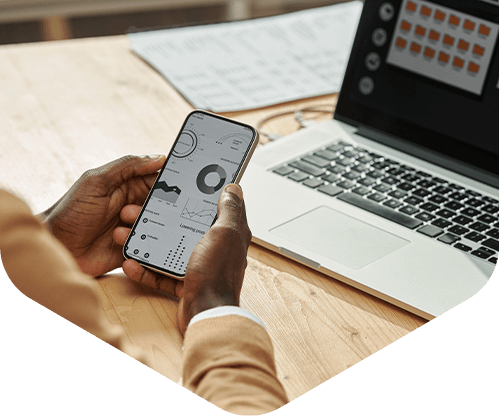The Importance of Mobile App Testing and Quality Assurance
Mobile apps are a powerful tool for businesses and organizations to engage customers, streamline operations, and unlock new revenue streams.
As a result, a lot of emphasis is placed on mobile app quality assurance (QA).
Poor-quality apps will likely be rejected by users and can harm the business’s reputation and bottom line. A mobile app development company will thoroughly test the app it builds for you. If you’re developing it yourself, however, you may see QA as a place where you can save time and resources.
This article explores the importance of testing and quality assurance in the mobile app development lifecycle. We cover best practices to follow, helpful tools to use, and the reasons why mobile app QA testing is not where you should cut corners.
The Benefits of Mobile App Testing and QA
Mobile app testing and QA are designed to ensure that an app meets its specifications, performs as expected, and provides a satisfying user experience across a wide range of devices, operating systems, and network conditions.
Ensuring User Satisfaction
In the highly competitive mobile app market, user satisfaction can make or break your app. Users expect applications to be intuitive, fast, and flawless.
Even minor issues, such as a hard-to-navigate user interface or a slow response time, can lead to frustration and, ultimately, abandonment. More severe problems, like crashes or data loss, can result in negative reviews and irreparable harm to the app’s reputation.
Rigorous testing helps ensure a high-quality user experience by identifying and addressing issues before they reach the end user. By thoroughly testing an app, developers can ensure that it functions correctly and delivers a smooth, enjoyable user experience.
Boosting App Performance
Users expect mobile apps to be fast and reliable. Performance-related issues, such as slow load times or sluggish responsiveness, can quickly lead to user dissatisfaction and churn.
Performance testing is a critical part of mobile app quality assurance. It’s crucial to ensure that an app can handle peak loads, respond quickly to user interactions, and operate smoothly under various network conditions.
Performance testing can help identify bottlenecks, optimize resource usage, and improve the app’s overall performance.
It can also simulate different network conditions and loads to ensure the app can perform satisfactorily even under extreme conditions.
Guaranteeing Security
As data breaches and cyberattacks continue to grow, ensuring the security of mobile apps is more critical than ever.
Mobile apps often deal with sensitive data, such as personal information, payment details, and business-critical data. Malicious actors can exploit any vulnerability, leading to data breaches, identity theft, and other severe consequences.
Security testing is an essential part of mobile app testing and QA. It involves identifying potential vulnerabilities, testing the effectiveness of security measures, and ensuring that the app complies with relevant security standards and regulations.
It also helps build user trust, protect sensitive data, and avoid legal issues, fines, and damage to the app’s reputation associated with security breaches.
Achieving Market Readiness
The mobile device landscape is incredibly diverse, with many devices, operating systems, screen sizes, and network conditions. An app that works perfectly on one device may fail on another due to differences in hardware, software, or network connectivity.
Compatibility testing is crucial to ensure that an app functions correctly across this diverse landscape. It involves testing the app on various devices, operating systems, and network conditions to ensure a consistent user experience.
Testing for device compatibility helps ensure that the app is market-ready and can reach the broadest possible audience.
Cost-Efficiency
Lastly, mobile app QA testing early in the development lifecycle can save a significant amount of time, effort, and money.
Identifying and fixing issues after launching the app can be costly and time-consuming. It may also harm the app’s reputation and user satisfaction.
Early testing allows issues to be identified and addressed while they are relatively easy and inexpensive to fix. It also helps avoid costly rework, delays in delivery, and potential revenue loss.
Best Practices for Mobile App Testing and Quality Assurance
Implementing best practices in mobile app quality assurance can significantly improve the efficiency and effectiveness of these activities. Here are some recommended best practices:
Start Early and Test Often
The earlier testing is incorporated into the development process, the better. Starting to test in the initial stages of the development process can help identify and address issues before they become deeply ingrained in the code, making them easier and cheaper to fix.
Moreover, mobile app QA testing should not be a one-off activity but a continuous process. Regular testing throughout the development cycle can help catch new issues as they arise and ensure that fixes have not introduced new problems.
Test on Real Devices
While simulators and emulators can be helpful for preliminary testing, they cannot fully replicate the performance and behavior of actual devices. Real devices have specific hardware, software, and network characteristics that can significantly affect an app’s performance and user experience.
Therefore, it’s essential to test the app on a representative sample of devices the target audience uses. This will provide a more accurate assessment of the app’s performance, functionality, and user experience.
Automate Where Possible
Manual testing can be time-consuming and error-prone, especially for large and complex apps. Automation can significantly speed up the testing process, increase coverage, and reduce the risk of human error. Automated tests can be run repeatedly and consistently, making them particularly useful for regression testing.
However, automation is not a silver bullet. Some aspects, such as usability testing, require human judgment and are challenging to automate effectively. Therefore, a balanced approach that combines automated and manual testing is often the best strategy.
Cover All Testing Types
Mobile app testing is not just about checking if the app works as expected. It involves a wide range of testing types, each focusing on a different aspect of the app.
Functional Testing verifies that the app’s features and functionalities work as expected.
Usability Testing ensures the app is easy to use and provides a good user experience.
Compatibility Testing checks that the app works correctly on various devices, operating systems, and network conditions.
Performance Testing ensures the app performs well under different loads and conditions.
Security Testing identifies potential vulnerabilities and ensures the app can protect sensitive data.
Prioritize Based on User Scenarios
Given the variety of devices, operating systems, and user scenarios, it’s impossible to test every possible combination. Therefore, it’s essential to prioritize tests based on user scenarios and business impact.
The most critical functionalities and those most frequently used by the target audience should be tested first and most thoroughly. Similarly, the target audience’s most popular devices and operating systems should receive the highest testing priority.
Continuous Integration and Continuous Deployment (CI/CD)
CI/CD practices can significantly enhance the effectiveness of mobile app testing and QA. Continuous Integration involves integrating code changes frequently and automatically testing them to catch issues early. Continuous Deployment involves automating the deployment process to ensure a smooth and speedy delivery.
CI/CD practices can help identify and address issues quickly, reduce manual effort, and ensure faster and more reliable delivery. They also promote a culture of quality and accountability, as every change is tested and traceable.
Helpful Tools for Mobile App Testing and Quality Assurance
Choosing the right tools can make a significant difference in the effectiveness and efficiency of mobile app testing and QA. Here are some popular tools:
Appium
Appium is an open-source tool for automating mobile app testing. It supports native, mobile web, and hybrid apps on both iOS and Android platforms. Appium allows writing tests in multiple programming languages, making it a flexible choice for diverse teams.
Calabash
Calabash is an open-source tool for automated acceptance testing of Android and iOS apps. It allows writing and executing tests in a natural language format, making it easier for non-technical stakeholders to understand and contribute.
Espresso
Espresso is a testing framework provided by Google for Android apps. It’s widely used for its advanced synchronization capabilities, which automatically manage the speed of test execution to ensure reliable results.
XCTest
XCTest is a testing framework provided by Apple for iOS apps. It integrates seamlessly with Xcode, Apple’s IDE, making it easier to write and run tests. XCTest supports both unit testing and UI testing.
JIRA
JIRA is a popular project management tool for tracking bugs, issues, and tasks throughout the development lifecycle. It provides comprehensive planning, tracking, and reporting features, making it easier to manage and coordinate testing efforts.
TestRail
TestRail is a comprehensive test case management tool that helps manage and track software testing efforts. It provides powerful features for creating test cases, managing test runs, and reporting results.
Jenkins
Jenkins is an open-source tool used for continuous integration and continuous delivery. It automates the process of building, testing, and deploying applications, making it easier to continuously test and deliver high-quality apps.
Sauce Labs
Sauce Labs is a cloud-based platform for testing web and mobile applications. It provides access to many virtual and real devices and operating systems, enabling extensive compatibility testing without needing a physical device lab.
Mobile App Success Requires Testing and QA
Given the fierce competition in the app marketplace, having just “okay” app performance is no longer sufficient. An app must deliver a seamless, bug-free user experience to satisfy users and keep them coming back.
Mobile app testing and QA processes take time and resources, but the payoff in terms of an app’s longevity and success in the market is invaluable.
A well-tested app, validated through rigorous QA processes, ensures a high-quality product that wins customer trust and enhances the brand’s reputation.
Integrating robust mobile app testing and QA strategies within the development process can set the stage for delivering high-quality, successful apps that resonate with users and stand the test of time.


